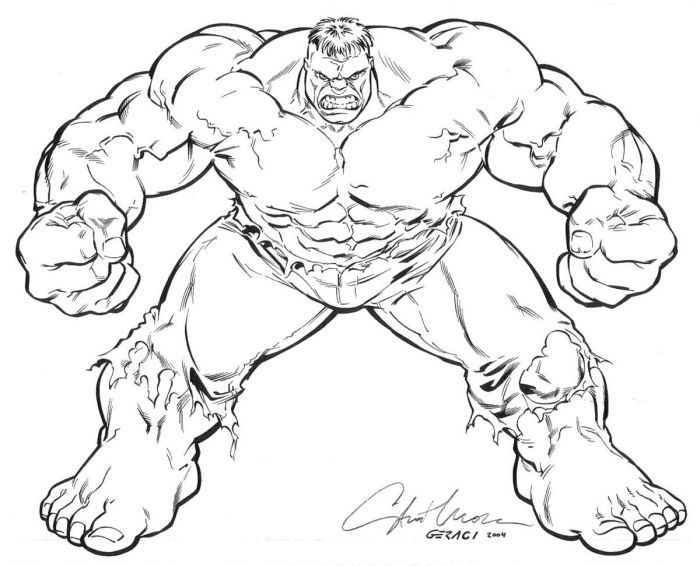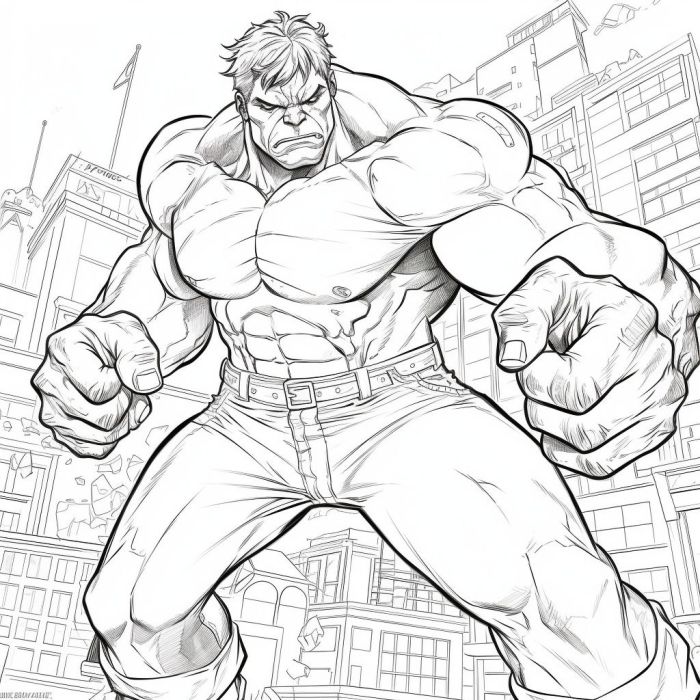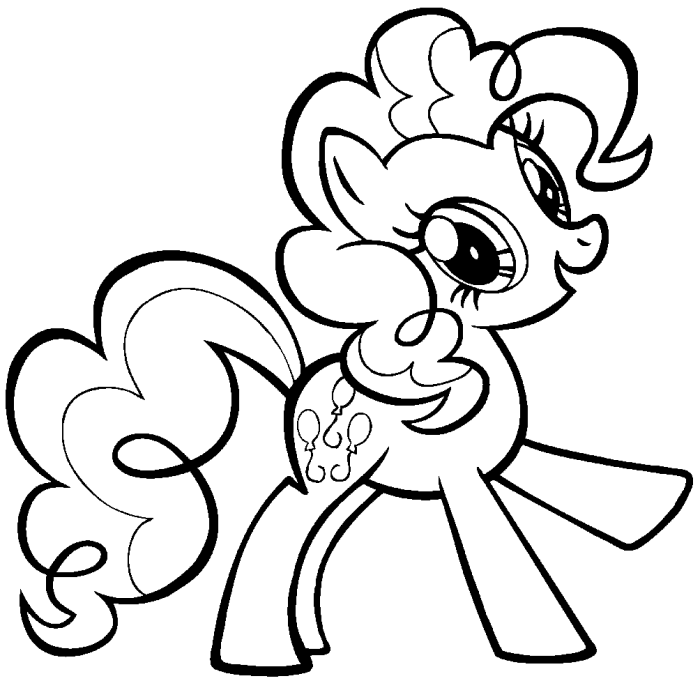Coloring Page Activities and Extensions: Hulk Coloring Book Pages

Hulk coloring book pages – Extending the coloring page activity beyond simply filling in colors allows children to engage in more creative and enriching experiences. These activities foster imagination, fine motor skill development, and storytelling abilities, all while reinforcing the fun of coloring. The following suggestions offer engaging ways to build upon the initial coloring experience.
These activities provide opportunities for children to develop their creativity and problem-solving skills, transforming a simple coloring page into a multi-faceted project. The use of diverse materials also encourages exploration and experimentation with different textures and artistic techniques.
Hulk Coloring Page Activity Ideas
Here are three creative activities children can pursue after completing their Hulk coloring pages, along with step-by-step instructions for parents or educators.
- Adding Textures to Hulk: This activity enhances the visual appeal and adds depth to the Hulk coloring. Children can experiment with various materials to create different textures, representing Hulk’s powerful musculature or the roughness of his skin.
- Creating a Hulk Story: This activity encourages storytelling and imaginative play. Children can create a narrative around their Hulk coloring, developing a story that involves the character’s actions, challenges, and triumphs.
- Making a 3D Hulk Model: This activity introduces children to basic three-dimensional modeling techniques. They can use their coloring page as a template to construct a three-dimensional representation of Hulk, enhancing their spatial reasoning and crafting skills.
Step-by-Step Guide for Creative Activities
These steps offer a structured approach to implementing the suggested activities, making them easily manageable for parents and educators.
- Adding Textures:
- Gather materials: Sandpaper, textured paper, fabric scraps, glitter glue, etc.
- Identify areas: Decide which parts of the Hulk image will receive textural enhancements (muscles, clothing, etc.).
- Apply textures: Carefully apply the chosen materials to the designated areas of the coloring page.
- Creating a Hulk Story:
- Brainstorm ideas: Discuss potential story elements with the child, such as setting, characters, and plot points.
- Develop the narrative: Help the child structure their story, ensuring a clear beginning, middle, and end.
- Write or illustrate: Encourage the child to write or draw their story, using the Hulk coloring page as inspiration.
- Making a 3D Hulk Model:
- Prepare materials: Cardboard, scissors, glue, paint, etc.
- Cut and shape: Cut out the Hulk image from the coloring page and use it as a template to create a 3D shape.
- Assemble and decorate: Assemble the 3D model and decorate it using paint, markers, or other materials.
Effects of Different Coloring Tools
The choice of coloring tools significantly impacts the final appearance of the Hulk coloring page, affecting both the color intensity and the overall texture.
- Crayons: Crayons produce a waxy, slightly textured finish. Colors tend to be less vibrant and can be easily layered, allowing for blending and shading. A Hulk colored with crayons might have a softer, more playful appearance.
- Markers: Markers provide bold, vibrant colors with a smooth, consistent finish. Layering can be more challenging, but the intensity of the color makes the Hulk appear powerful and dramatic.
- Colored Pencils: Colored pencils offer a versatile approach, allowing for both delicate shading and bold color application. The final look can range from subtle and realistic to vibrant and expressive, depending on the pressure applied and layering techniques used. A Hulk colored with colored pencils could exhibit detailed muscle definition and subtle color variations.
Accessibility Considerations for Coloring Pages

Creating inclusive coloring pages ensures that children of all abilities can enjoy the activity. Accessibility features go beyond simply making the pages larger; they involve thoughtful design choices that cater to diverse needs, particularly those of children with visual or motor impairments. This section will detail several key considerations for designing accessible Hulk coloring pages.
Hulk Coloring Page Design for Visual Impairments
A Hulk coloring page designed for children with visual impairments should utilize bold Artikels and high-contrast color schemes. For example, a bright green Hulk against a deep purple background would provide excellent contrast, making the image easier to distinguish. The lines defining Hulk’s features, such as his muscles and facial features, should be significantly thicker than those found in standard coloring pages.
This increased line weight allows for easier tracing and coloring, even with limited vision. Consider using a simplified design, focusing on key features rather than intricate details, to reduce visual clutter and improve clarity. A bold, simple representation of Hulk’s head and torso, for instance, would be more accessible than a highly detailed full-body image.
Large Print and Simplified Designs Enhance Accessibility, Hulk coloring book pages
Larger print sizes significantly improve accessibility for children with low vision or visual processing difficulties. This allows for easier identification of shapes and lines. Simplified designs, featuring fewer intricate details and larger, bolder shapes, reduce visual complexity, making the coloring experience less overwhelming and more manageable. For example, instead of a highly detailed cityscape in the background, a simple, large, single-color block representing the background would be easier to interpret and color.
This approach minimizes visual distractions and allows the child to focus on the main subject – Hulk.
Tactile Elements for Children with Visual or Motor Impairments
Incorporating tactile elements into the coloring page can significantly benefit children with visual or motor impairments. Raised lines, created through embossing or other techniques, can provide a tactile guide for tracing and coloring. Different textures, achieved through materials like textured paper or applied materials, can add another layer of sensory input, making the experience more engaging and easier to navigate.
For instance, raised lines could Artikel Hulk’s muscular physique, allowing a child to trace the shape without relying solely on vision. Similarly, varying textures could represent different parts of the image, such as a smooth texture for Hulk’s skin and a rougher texture for his clothing. This multi-sensory approach enhances engagement and understanding.
Hulk coloring book pages offer a fun way for kids to express their creativity with the iconic green giant. For a broader range of characters, however, you might also consider exploring other options like printable coloring book pages disney , which feature beloved Disney characters. Returning to the Hulk, remember to select pages that match the child’s skill level for an enjoyable coloring experience.










